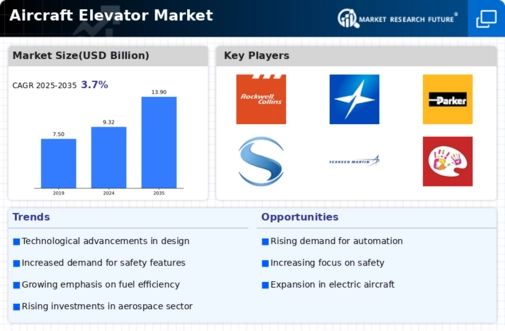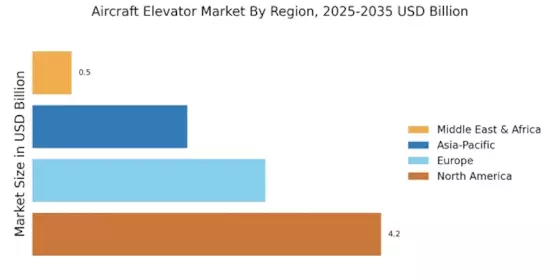Focus on Fuel Efficiency
The Aircraft Elevator Market is increasingly driven by the aviation sector's focus on fuel efficiency. Airlines are under pressure to reduce operational costs and minimize their environmental impact, prompting a shift towards more fuel-efficient aircraft designs. Elevators play a crucial role in the overall aerodynamics of an aircraft, and advancements in elevator technology can contribute to improved fuel efficiency. Manufacturers are exploring lightweight materials and innovative designs that enhance the performance of elevators while reducing drag. This trend is likely to propel the Aircraft Elevator Market as airlines seek to optimize their fleets for better fuel economy.
Technological Innovations
Technological advancements play a pivotal role in shaping the Aircraft Elevator Market. Innovations such as fly-by-wire systems and advanced materials are revolutionizing the design and functionality of aircraft elevators. These technologies not only enhance the performance and reliability of elevators but also contribute to weight reduction, which is crucial for fuel efficiency. The integration of smart technologies, such as sensors and automation, is also becoming prevalent, allowing for real-time monitoring and maintenance. As the industry embraces these innovations, the Aircraft Elevator Market is likely to witness a transformation that aligns with the evolving needs of modern aviation.
Increasing Air Travel Demand
The Aircraft Elevator Market is experiencing a surge in demand due to the increasing number of air travelers. As more individuals opt for air travel, airlines are compelled to expand their fleets, which in turn drives the need for advanced aircraft components, including elevators. According to recent data, the air travel sector is projected to grow at a compound annual growth rate of approximately 4.5% over the next decade. This growth necessitates the production of more aircraft, thereby enhancing the demand for reliable and efficient elevator systems. The Aircraft Elevator Market must adapt to this rising demand by innovating and improving the performance of elevator systems to ensure safety and efficiency in modern aircraft.
Regulatory Standards and Compliance
The Aircraft Elevator Market is significantly influenced by stringent regulatory standards and compliance requirements. Aviation authorities worldwide impose rigorous safety and performance standards for aircraft components, including elevators. Compliance with these regulations is essential for manufacturers to ensure the safety and reliability of their products. The increasing focus on safety in aviation has led to the development of more comprehensive testing and certification processes for aircraft elevators. As a result, manufacturers are investing in research and development to meet these standards, which may lead to enhanced product offerings in the Aircraft Elevator Market.
Emerging Markets and Regional Growth
The Aircraft Elevator Market is witnessing growth in emerging markets, where air travel is becoming increasingly accessible. Countries in Asia and Africa are experiencing rapid economic development, leading to a rise in disposable incomes and a growing middle class. This demographic shift is driving demand for air travel, prompting airlines to expand their operations and invest in new aircraft. Consequently, the need for advanced aircraft components, including elevators, is on the rise. The Aircraft Elevator Market must strategically position itself to capitalize on these opportunities in emerging markets, ensuring that it meets the unique demands of these regions.


















Leave a Comment